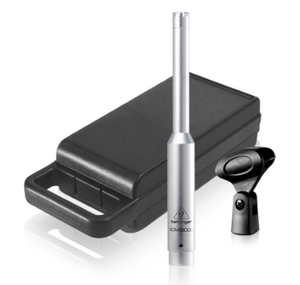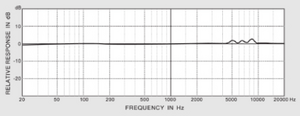Behringer ECM8000 specifications: Difference between revisions
Jump to navigation
Jump to search
No edit summary |
|||
| (3 intermediate revisions by the same user not shown) | |||
| Line 1: | Line 1: | ||
[[File:Behringer_ECM8000_microphone.png|Behringer ECM8000]] | [[File:Behringer_ECM8000_microphone.png|thumb|Behringer ECM8000]] | ||
[[File:Behringer_ECM8000_microphone_frequency_response.png|thumb|Behringer ECM8000 frequency response]] | |||
==Description== | ==Description== | ||
The Behringer microphone | The Behringer microphone can be used for measuring frequency response curves in sound experiments. | ||
*Ultra-linear condenser microphone | |||
*Perfectly suited for room equalization application | |||
*Exceptionally flat frequency response and ultra-high sound resolution | |||
*Evenly weighted, true omnidirectional pattern | |||
*Works with phantom power from +15 to +48 V | |||
*Perfect for use with the Behringer ULTRACURVE or any other analyzer | |||
*Ultra-low noise transformerless FET input eliminates low-frequency distortion | |||
*Gold-plated 3-pin XLR connector | |||
Latest revision as of 09:14, 24 November 2023


Description
The Behringer microphone can be used for measuring frequency response curves in sound experiments.
- Ultra-linear condenser microphone
- Perfectly suited for room equalization application
- Exceptionally flat frequency response and ultra-high sound resolution
- Evenly weighted, true omnidirectional pattern
- Works with phantom power from +15 to +48 V
- Perfect for use with the Behringer ULTRACURVE or any other analyzer
- Ultra-low noise transformerless FET input eliminates low-frequency distortion
- Gold-plated 3-pin XLR connector